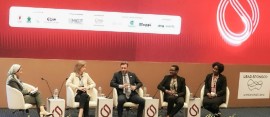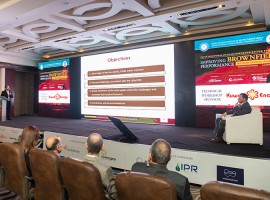Setting a clear strategy and a realistic direction for future modernization of the Egyptian oil and gas industry.
By Nataša Kubíková
Months of diagnostic analyses, weeks of assessment sessions, hours of interviews, thousands of survey data, hundreds of verification calculations, and dozens of townhall meetings mark the launch of an overhaul Modernization Program starting in 2017 that the Egyptian oil and gas industry has embarked upon for the next three to five years at an average investment of $30 to $40 million.
All these efforts signify the new beginning for a committed engagement in upgrading the hydrocarbon industry, the flagship of Egypt’s economy. The objective of this program, outlined by the Oil Ministry is “to design and implement an integrated transformative program for Egypt’s oil & gas sector to enhance its contribution as an engine of economic growth and to reinforce its role,” explained in an exclusive interview with Egypt Oil&Gas, Osama El-Saadawy, Marketing Manager at Oil&Gas Skills (OGS) and Team Leader for the Program’s People Agenda Initiative.onths of diagnostic analyses, weeks of assessment sessions, hours of interviews, thousands of survey data, hundreds of verification calculations, and dozens of townhall meetings mark the launch of an overhaul Modernization Program starting in 2017 that the Egyptian oil and gas industry has embarked upon for the next three to five years at an average investment of $30 to $40 million.
A comprehensive outlook of the program demonstrates a large scope of activities that lie ahead of the industry’s actors. Industry leaders have set their sights on achieving an efficient, self-sufficient, and empowered sector. According to the mission of the Modernization Program teams, there are four key aspirations based on preliminary assessments. These would lead to establishing a well governed and functioning industry environment with a steady flow of investments and world class human capital, a basis for securing improved performance of the sector.
The country’s vision, according to Oil Minister, Tarek El Molla, is for “the oil and gas sector to continuously unlock the sector’s full value chain potential as a growth and a sustainable development engine for Egypt to achieve financial sustainability, become regional oil and gas hub and a role model for the future of modernized Egypt by 2021.”
Diagnostics, Assessment
Public and private companies, individual industry executives participated in the three-month-long assessment process led by Wood McKenzie from August to October 2016. “Data collection and interviews with different stakeholders were essential for the sector to identify the main challenges and leverage points” and help decipher the current state of sector’s health and performance, further noted El-Saadawy.
To identify the direction of the program, an appointed project management unit verified and facilitated work across the companies including IOCs, taking stakeholders’ management’s diagnostics into consideration. The Oil Ministry stated it held “a series of day-long workshops to chart the path forward for the sector engaging some 50 leaders” with an intention to collectively define a clear vision. The executives participating in the diagnostic stage of the Modernization Program proposed “61 improvements, which were synthesized into 11 actionable initiatives and consolidated into 6 programs to modernize the sector,” the ministry’s presentation shared exclusively with Egypt Oil&Gas revealed.
A follow-up workshop with mid-level management came as a part of monitoring progress and sharing information with future leaders from across the sector for awareness and buy-in discussions.
As a result of these concentrated endeavors, the Oil Ministry and Modernization Program Realization Office (RO) have been preparing a comprehensive road map that will set dozens of milestones in efforts to improve the industry’s state of health in each and every segment.
Rationalizing the organization in a way that will best help to achieve set objectives and come closer to the stated vision will determine the looks of the industry in the future and its success. RO is thus searching for apt ways to generate new ideas, include a new generation in designing the sector’s future, and in such a decentralized environment create stand-alone profitable organizations that will positively contribute to the overall macro-economics of the hydrocarbon sector in Egypt.
Modernization Program Structures
The Modernization Program stands on two main pillars: sector governance and organizational health on one side and enhanced performance on the other.
“I believe that the sector health is the core of this modernization. If we succeed in creating a healthy system, it will have a great impact on performance of companies and help transform these companies into profitable units,” stressed Osama El Saadawy. Corporate governance will indeed play a role and offer opportunities to companies to form permanent sustainable structures.
The Modernization Program, as summarized by the Oil Minister, relies on key action areas. They range from “tailored investment vehicles to attract diverse investors given new growth opportunities” to “simplified sector structure with autonomous and independent entities focused on operations across value chains segments.” Furthermore, as the Oil Minister, Tarek El Molla, stated in his presentation at US Business Mission Forum in 2016, strength of the program relates to “adherence to international governance standards with high performing boards and performance transparency” as well as “streamlined portfolio of affiliated companies able to compete in the free market.” Notably, “world class talent management that recognizes performance and encourages entrepreneurship” will remain one of the government’s priorities.
Egypt has thus identified six major initiatives (Table 1) to tackle and successfully resolve industry’s challenges, according to an Oil Ministry’s presentation material.
Under the first pillar that revolves around sector’s healthy governance, there are three initiatives. The first is Investment Attraction that is envisioned to “streamline current concession processes and expand concession agreement portfolio.” The second, entitled Sector Structure Reform aims to “establish an independent regulator, create single SOE coverage across the value chain, and rationalize portfolio of both operations and companies involved in the Egyptian industry.” The third initiative targets People Agenda and seeks to “introduce comprehensive talent management system and redeploy people to drive efficiency.”
The second pillar forms an umbrella for actions regarding sector’s performance in Downstream and Upstream. The ministry seeks to “optimize downstream and petrochemical sourcing, output and mass balancing.” “To drive operations performance transformation” is an effort identified for both sectors. The last sixth initiative talks about Egypt as Regional Oil&Gas Hub, which is to be achieved by “optimizing and leveraging existing oil and gas transport and storage infrastructure.”
However, the Modernization Project “will not take a step forward without the engagement and cooperation of oil and gas leaders together with the support of our international partners,” as Minister El Molla said in his speech, presented by Eng. Mohamed Mounes, Undersecretary for Production at the Oil Ministry, at Egypt Oil&Gas’ People Development Roundtable held in December 2016.
And it is indeed both local and foreign experts’ knowhow and experience that the program will rely on. “Their [international partners’] own experience in similar projects will guide us in such change,” Eng. Mounes continued in presenting the Minister’s words.
Furthermore, this program is closely linked to the Oil Ministry’s strategic pillars and action areas (Table 2), as the Oil Minister had previously outlined in his presentation at the US Business Mission Forum. The pillars target energy security, financial sustainability, and sector governance. The action plans thus endorse Egypt’s 2030 vision to build up a modernized and self-sustainable industry. And with this in mind, arrears and subsidies will remain the priority to consider.
Nonetheless, there is no doubt that “this project creates confidence in Egypt oil and gas sector and its future outlook, especially with regards to specific benefits to international partners,” as the minister’s message at the December roundtable sounded. It will thus “ensure the smoothness and governance of any projects with them [international partners] and build trust leading to a feasible business and investing environment in Egypt,” Eng. Mounes added.
Steps Ahead
As the assessment and diagnostics are progressing towards the formulation of a road map, some of the initiatives have been given a more concrete form and a fixed timeframe under the three-to-five year plan. For instance, the ministry insists that industry players will see a streamlined concession process already by the end of 2017, including concession agreement portfolio. In other areas, some work should be ready and completed for instance in demarcating sector roles of the government’s entities.

Moreover, other areas of interest continue being evaluated at this stage to see if these are worth include in the overhaul agenda at all such as information, communication technologies, standardization of application, bidding processes, and reporting.
Launching such a massive plan implies that the Oil Ministry would need to gain support from each and every leader in the industry, and each and every company or entity in the sectors. The endorsement by people is essential. In the end, the overall objective is to generate improvements for them. For this purpose, a list of fast-track actions has been prepared to showcase for people how the project will contribute to a strategic direction that the Egyptian industry will take and what economic benefits it will bring.
Therefore, as for the impact of the program, “we need to balance between the long term strategies and objectives, and quick wins that may happen, affecting certain, soon, and positive impacts,” clarified Modernization Program member, El-Saadawy.
RO is thus entering 2017 with a lengthy to-do-list encompassing activities such as stimulating debate, addressing route causes, designing, engaging, and encouraging people’s initiatives. In simple words, the Program Team needs to “create the case for modernization that will be sustainable in terms of profitability and good governance,” concluded Osama El-Saadawy.









